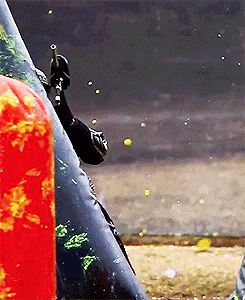Home
I made this website to help aspiring paintball players
understand and exploit the physics of paintball. Even
experienced players can significantly improve their paintball
performance by learning how paintballs act after being fired
from a paintball marker. I suggest paying extra attention to
the Time section.


Notation:
:
the terminal velocity of the projectile
: the
mass of the projectile
: the
gravitational acceleration on the projectile
: the
density of the fluid through which the object is moving
: the
projected area of the object
:
the drag coefficient of the projectile
:
the projectile acceleration in the x direction
:
the projectile acceleration in the y direction
: the
time difference from when the projectile is launched
:
the projectile velocity in the x direction
:
the projectile velocity in the y direction
:
the initial velocity at which the projectile is launched
:
the angle at which the projectile is launched
: the
magnitude of the sum of the x and y velocity vectors
: the
distance from the origin in the x direction
: the
distance from the origin in the y direction
:
the average force on the projectile
:
the change in velocity of the projectile
:
the difference in time
the
difference in position of the projectile
:
the change in momentum of the projectile
Contsants:
(average mass of a paintball)
(gravity on earth)
(air density at 1 atm and 30 degrees celcius)
(cross sectional area of a paintball)
(drag coefficient for a smooth sphere)
(diameter of a paintball)